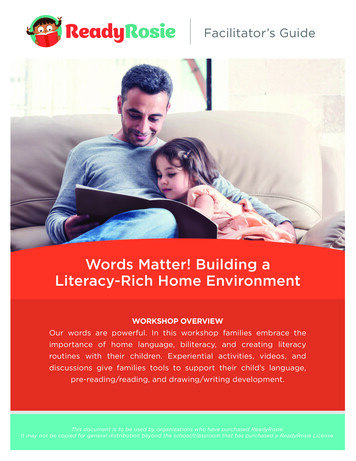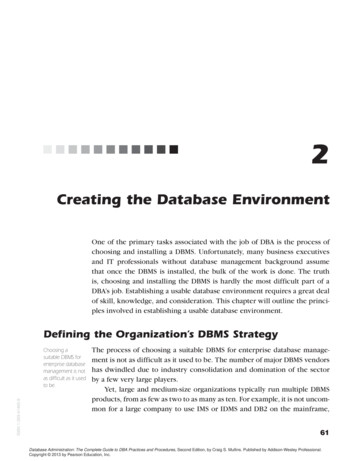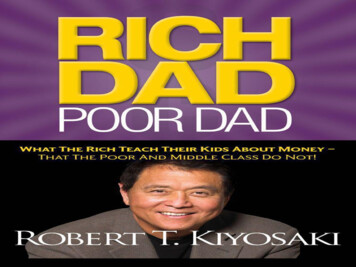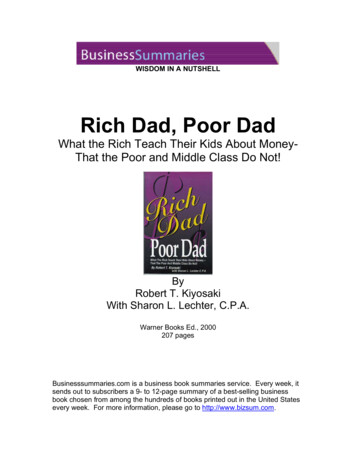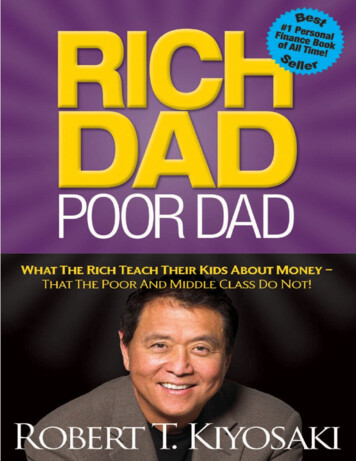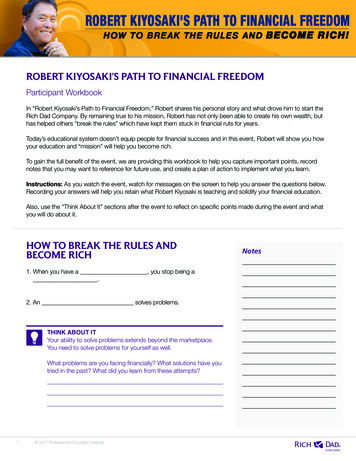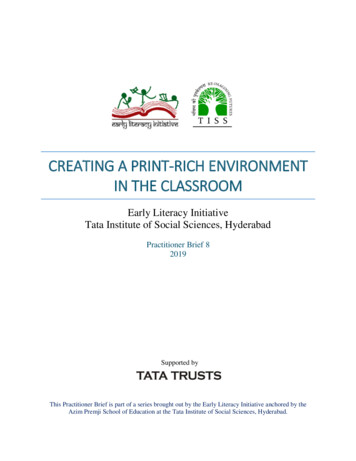
Transcription
CREATING A PRINT-RICH ENVIRONMENTIN THE CLASSROOMEarly Literacy InitiativeTata Institute of Social Sciences, HyderabadPractitioner Brief 82019Supported byThis Practitioner Brief is part of a series brought out by the Early Literacy Initiative anchored by theAzim Premji School of Education at the Tata Institute of Social Sciences, Hyderabad.
TISS, HyderabadELI Practitioner Brief 8CREATING A PRINT-RICH ENVIRONMENT IN THE CLASSROOMTry to visualize the Grade 1 classroom described here.As soon as one enters the classroom, one sees rows and rows of akshara cardsand students’ artwork hanging down from the ceiling. High up on one side ofthe blackboard is the school prayer song and at a similar height, on the otherside, is the varnamala, both painted in bold black on a bright, yellowbackground. On the other three walls, there are a couple of charts withbalgeet/ poems and inspirational quotations. The previous language teacherbought these charts last year. Students’ notebooks and textbooks are kept ina rack at the corner. Stacked behind these are a couple of children’s booksand magazines for older children. Overall, it is a very colorful and invitingclassroom.Would you call this a print-rich classroom? Why or why not?Many teachers believe that classrooms like this one are “print-rich”. But we think these are notbecause, if you look closely, it is clear that print usually serves a decorative function in theseclassrooms and it is not used in classroom transaction. What, then, is a truly print-richenvironment?A print-rich environment is one where young children getmany different opportunities to interact with many differentforms of print. That is, in order to be truly print-rich, aclassroom needs to display and use print meaningfully duringteaching and learning. This exploration of print in meaningfulcontexts and observing adults around use print is critical forliteracy development because it shows children that printcarries meaning and that reading and writing serve real,everyday purposes. Over time, children become motivated to tryto read and write themselves (Abraham, 2003).1
TISS, HyderabadELI Practitioner Brief 8Children who have exposure to books and print at home may appear to pick up many thingsabout print “naturally”. However, in actuality, children learn these things in print-richenvironments. Thus, for children who may not have this exposure at home, it is even moreimportant that teachers provide a print-rich environment at school to enhance their literacylearning. In this handout, we present ways to help you design a print-rich classroom and to usethis print in your language instruction.Using Print in the Environment 1Display a variety of print around the classroom, including print created by students. Show yourstudents how to use this print and encourage them to use it. Create daily routines or excitingactivities that demonstrate the purpose of this print. In multilingual classrooms, it is importantthat you use both students’ home languages along with the school language for this print. In thissection, we list the different categories of print you could use in your classroom.Print That Labels Things or SpacesUse labels that tell students what things are or where things belong. Some suggestions include: Label things with their names (for example, black board, chalk, comb, mirror, etc.) Label shelves and containers used to hold materials. You can use print and pictures for theselabels for students to start associating names easily with their meaning and function. Label the different areas in the classroom (e.g. “reading corner”, “writing corner”, etc.).The ideas in this brief have been adapted from ‘Literacy Centres in Preschool Settings’ by Shailaja Menon(personal communication, 1 September, 2018).12
TISS, HyderabadELI Practitioner Brief 8Let children see you making these labels, and invite them to make their own signs and labels.Try to include and use common signs and symbols that children see in their surroundings (e.g.‘stop’ and ‘danger’ signs, signage for men’s and women’s toilets, popular brand symbols formilk/ biscuits/ chocolates, etc.). This helps children see how print is used in daily life.Print That Reminds Students What to DoDisplay print around the classroom that reminds students how to use a particular thing or space.Some examples include: Simple rules or instructions that you have discussed with students (e.g. “Ssshh! You arein the reading corner!”, “Put your bags and tiffin boxes here”, etc.). Draw students’ attentionto their use, even if they cannot yet read conventionally. For example, after they finishreading, remind them to replace books neatly in the reading corner by pointing to andreading out the corresponding label (shown in Figure 1).Figure 1. Print reminding students how to replace books in the reading corner. QUEST, Maharashtra Signs made by students (for example, “Please do not touch our project”).Print That Informs StudentsDisplay and use print that provides information to students. This print can take many forms.Some examples are listed below: Students' names on artwork (written by children or dictated to an adult). Descriptions of students’ artwork or writing attempts, posted next to the work itself (shownin Figure 2). These descriptions are dictated to an adult who writes the child's words.3
TISS, HyderabadELI Practitioner Brief 8Figure 2. A note describing a child’s work2Figure 3. Class name chart, OELP, Rajasthan Students’ name-chart. This can be used for different activities (see Figure 3). For example,ask students to run and find names starting/ ending with a particular letter or sound. Alphabet/ Varnamala charts hung at children's eye-level. If you are teaching a specificakshara group, display that group prominently and use it during the lesson (see the lastsection for word study activities). For English, both upper case (capital) and lower case(small) letters should be displayed, as shown in Figure eracydiet/Home/index.html4
TISS, HyderabadELI Practitioner Brief 8 ‘Word walls’ with words that your class commonly uses or encounters (e.g. aai, mama,baba, tai, kaku, gaay, ghar, paani, etc.). They could refer to this chart when they want toread/ write some of these words. Students can themselves write these words on small cardsheets with your guidance. If you set up the word wall as shown in Figure 5, the older wordcards can be retained as students add new ones. Picture dictionary charts. Figure 6 shows an example. Students can create these, with yoursupport. Charts describing steps for creating something (e.g. recipe, origami) with both words andpictures (see Figure 7).Figure 7. Chart describing steps for makingthumbprint figures, Awesome Art and CoolCrafts, Scholastic, 2011Figure 6. Picture Dictionary, Sita School,BangalorePrint That Elicits ResponseInclude print in your classroom that asks students to respond or contribute. Examples include: Attendance charts (students can sign against their name or put checks next to their nameson a list, as figure 8 shows). Daily/ weekly class schedule. As Figure 9 shows, take students through the plan for theday every morning, perhaps also assigning tasks and responsibilities to students.5
TISS, HyderabadELI Practitioner Brief 8 Sign-up sheets (e.g. where students have to sign up for a classroom task). Record sheets (e.g. students can maintain a list of books that you have read-aloud to them).Figure 8. Child signing hername on the attendance chart,QUEST, Maharashtra Figure 9. Teacher discussing the dailyschedule with students, QUEST, MaharashtraSurveys in which students can answer a question by writing their names in the appropriateplace. Figure 10 shows a variation. The chart asks for students’ response after the teacherread out the book Dear Zoo (Rod Campbell, 1982). Students color, label and stick thepicture of the animal they want from the zoo.Figure 11. Poem postercreated by childrenFigure 10. Chart asking children torespond with their favourite animal.6
TISS, Hyderabad ELI Practitioner Brief 8Language experience charts (where you record students’ stories, recollections of a sharedexperience, say a recent trip to a market/ haat etc.) or other collaborative writing workcreated by students. Poem charts and story posters/ charts that students have recently read/ heard. Use this printduring shared reading sessions. Students would love to recite poems and songs they haveheard at school and outside. You can use these to create the posters. Older students cancopy the text that you give them on a sheet of paper and younger students could help inadding illustrations. Figure 11 shows an example.As we said earlier, displaying print is not sufficient by itself; refer to this print in classroomroutine and teaching-learning activities. This naturally means that the displays have to bechanged regularly based on what students are learning. This is why any print painted on thewalls, like the classroom at the beginning of the handout, is likely to have limited use. Displaysmust also be hung at students’ eye level and font used must be large enough to be seen fromacross the room.In addition to general print in the environment discussed earlier, it is important that you alsohave specific ‘reading-’, ‘writing-’ and ‘word-study’ corners in the classroom. The next threesections will give you detailed information about what these corners are and how you can setthem up in your classroom.Setting up a Reading Corner / Classroom LibraryA classroom library, or a reading corner, well stocked with children’s books for students tobrowse and read on their own, is a great space to have in the classroom. Don’t be discouraged ifyou don’t have many books to start with. You can still set up this corner and build the collectionas resources become available. You could also use books from the school library and rotate thecollection every couple of days. Figure 12 shows what a reading corner looks like.7
TISS, HyderabadELI Practitioner Brief 8Figure 12. Reading Corner, Mumbai Mobile Creches, MaharashtraSuggested Materials for the Reading Corner Arrangement for displaying books. If possible, use low, open shelves or low tables along thewall. But you could also display books by hanging them on wires (at students’ eye level), orby laying them on dhurries or in trays. Mat / rug/ space for students to sit and read. Different genres of books: fiction, non-fiction, poetry/ balgeet, alphabet books, picturebooks, wordless books, books made by students, activity books, children’s magazines,books of riddles, reference books like children’s dictionary and atlas, and so on. If you’reorganizing books (e.g. by genre, language, etc.), label them and tell students what thesecategories mean in simple terms. Books in both the home languages of students, as well as the languages taught at school. Basic stationery like plain paper, craft paper, pencils and colors, and so on. Puppets and props relevant to popular books read aloud in class.Suggested Activities at the Reading Corner Oral storytelling and read-alouds3. Oral storytelling involves narrating a story to childrenand discussing it with them; while in a read-aloud, you would use a book to read out the3Please refer to the ELI’s Practitioner Brief – 9 ‘Reading Aloud with Young Children’ for more details.8
TISS, HyderabadELI Practitioner Brief 8story. Not only storybooks, even non-fiction books (for example, books about animals orplants) can be read aloud to children. Shared reading. Shared reading is an important way to demonstrate how spoken languageand printed word are connected, and show children what fluent, expressive reading lookslike. It also gives you an opportunity to teach them different features and functions of print.Shared reading involves using a big book with large font and illustrations and tracking thetext word-by-word as you read it out. Re-read the book this way over a couple of days andinvite students to join in wherever they can. Books with repetitive words and phrases helpthem to do this easily. In some readings of the text, you can quickly discuss a feature ofprint4 (like different punctuation marks), for example, and how it affects meaning andexpression. If you don’t have access to big books, you can write out stories or poems orstudents’ experiences in big font on a chart paper and use that for shared reading. Story retelling. Support retelling of stories that students read together in class. Childrencan retell stories through role-playing, drama and puppetry. If students are providedinteresting props and material relating to a story/ book in the reading corner, you may findthem doing spontaneous retelling during their free time. But you could also teach this moreexplicitly in the language class. Remind students to talk about the characters, the setting,the sequence of events, and the main problem and its resolution, in their retelling. Independent/ free reading time. Allow students to read and explore books independently.This can be a part of the planned class time (for example, when one group is doing a guidedreading activity, another group could explore books in the reading corner). Or, you couldestablish some rules with students for using this space other than the specified time. Forexample, if a child finishes her class work sooner than the others, she can read books in thiscorner, and so on. Book-based activities. Use this corner for extended engagement with books includingwriting, drawing or art and craft based on a book, writing book reviews (could be simplecomments on post-its stuck on the inside cover of a book or on a chart with the book’sname) or other book-based activities (solving picture crosswords, etc.).4Please refer to the ELI’s Practitioner Brief, ‘Emergent Literacy’ for details on Concepts-about-Print.9
TISS, HyderabadELI Practitioner Brief 8The idea is to increase engagement with books and reading. So, create a welcoming corner, haveengaging reading experiences, display books in interesting ways (say, based on themes like rain,birds, friendship, favourite author, sports etc.), and organize exciting book-based activities. Startwith what you have and slowly build the collection, mindful of the genres available in thelanguages of your need and interest.Setting up a Writing CornerYou can set up a writing corner next to the reading corner. This is a space where students canscribble, draw, write, cut-and-paste, stamp, and otherwise engage with print using a variety ofmedia and material. As reading, writing, speaking and listening develop in interrelated ways inyoung children (Dyson, 1988), any ‘corner’ or literacy centre you set up should allow children toexpress and communicate using different modalities simultaneously.Suggested Materials for the Writing Corner Pencils (regular and colored), sketch pens, crayons, color pencils, paints, erasers,sharpeners, and so on. Paper, card sheets and chart paper (lined and unlined; different sizes and colors). Notepads and notebooks. Staplers and glue (to be handled by adults). Chalk (white and colored). Slates (if you have blackboard surfaces painted at the bottom of the walls, you could askstudents to write there as well). Puppets and props can be kept here too for dramatic retelling. If possible, keep clipboards or low tables to make it easier for students to write. ‘Word wall’, alphabet books, picture dictionaries can be displayed close to the writingcentre for students to refer to while writing. Stamps, that students can dip into paint and use. These can be letter and number shapes, ofanimals or other interesting objects from their environment. Clothes pegs and a string strung across the centre can be used to ‘peg’ students’ creationsonce done!10
TISS, HyderabadELI Practitioner Brief 8Suggested Activities at the Writing Corner Shared writing. You can demonstrate to your students how to write a shared account/ storythat they have composed. Invite them to come up to the chart paper, and add a letter, word,punctuation or a phrase as you write, depending on their level. Display these charts at thewriting corner, which can also be used for shared reading. Children, even emergent writers,can then attempt to write their own versions of the incident or story through words andpictures. Guided and free writing time. Encourage and support young children as they attempt (orpretend) to write, for example, stories, poems, posters, labels or list of rules for theclassroom, a letter or a birthday card. In guided writing, you can start by giving students aspecific purpose for writing and a quick ‘lesson’ on it. Say, they have to write recipes of theirfavourite evening snack. You can show them an example, tell them about the different partsof a recipe and their purpose. Students then work on their pieces individually. You can goaround talking to them about what they’re writing and sharing your feedback on it. At thispoint, focus on meaning; don’t worry about spelling and other conventions. Students can usea mix of drawing and writing, until they gain confidence in writing more conventionally.Display students’ work at the writing corner. ‘Chalk talks’. You can draw the story on the chalkboard or a chart paper while reading ortelling a story. This helps in children’s comprehension and children might attempt the samein retelling stories they have heard. (Likewise, puppets and props help in dramatic retelling).CREATIVE WRITING CORNER IDEASWriting need not be boring! You can be very creative in sparking students’ imagination at thewriting corner5. We have compiled some ideas here for you: Help students create their own storybooks6! It could be their own stories that you writeout on ‘book pages’ for them, which they illustrate. Older students can write their ownstories with invented spellings. Have students listen to each other’s stories and respond to5Except creating books, all ideas in this box have been taken from 6Refer to ELI’s Brief on “Children’s Writing: Creating Books in the Classroom” for more ideas and examples.11
TISS, HyderabadELI Practitioner Brief 8them. Display these books in the classroom for students to read these themselves and toeach other. Create a variety of writing stencils to get your students started. Figure 13 shows howthe teacher has provided some key words on the stencil that students can use in theirwriting. Students choose a stencil, trace the picture, brainstorm ideas, and write out their‘stencil stories’ on a sheet of paper.Figure 14. Theme-based writingcentre. www.weareteachers.comFigure 13. Writing Stencil.www.weareteachers.com Keep ‘Story Bags’ and ‘Story Jars’ at the writing centre. Each story bag (e.g. StoryBag #1, #2, etc.) will contain pictures/ names of everyday items in odd combinations tospark creative ideas. A story jar will contain several slips of paper, each one containingthe beginning of a story. Students pick one and then build on the idea. The same ideascan be used for poetry as well. Adapt your writing corner for theme-based dramatic play. Figure 14 shows anexample where, with simple changes, the writing corner is temporarily set up as a postoffice. It has plain paper, post-cards, envelopes, greeting cards, stamps, glue, postbox,and so on. Label these things and include simple instructions for using the ‘post-office’.Students can write and send letters, greeting cards, write addresses on envelopes, fill outsimple forms, etc. They can read out the letters addressed to them, in front of the class.This way, students engage with reading, writing, thinking, imagining, all during anengaging play activity.12
TISS, HyderabadELI Practitioner Brief 8Setting up a Word Study CornerIn the process of learning to read and write, young children need many occasions to make andbreak words, to think about how sounds and symbols are connected. The word study corner canbecome the space for this word-solving7. Ideally, you should have a separate corner for wordstudy but given the space constraints in our classrooms, you can club it with the writing corner.Please demonstrate and encourage students to sound out letters and words as they engage in theactivities we have described here.Suggested Materials for the Word Study Corner Letter/ akshara cards, and wire and clips (optional) to hang the cards up with. Please notethat for Indian languages it may be better to create aksharas that include maatras from thebeginning, as shown in Figure 15. For English, keep multiple cards for vowels and for highuse consonants. Letter blocks (for block printing).Figure 15. Akshara Cards, OELP, Rajasthan Sand trays for tracing letter shapes. Clay or playdough. Paper and card sheets (blank and lined). Writing materials (stamps, pencils, crayons, erasers, etc.).Refer to ELI’s Brief on ‘Learning the Script’ for more information on word-solving and a detailed list of classroomactivities to support it. We have described only a few in the current handout.713
TISS, Hyderabad ELI Practitioner Brief 8Cut out letters using different materials: velvet paper, sand paper, sponge, etc. Figure 16shows how children can touch and move these around and learn about the shape of letters. Name tags of everyone in class including the teacher. Alphabet books, rhyming books, word walls displayed nearby. If teaching English, use flip books or sliders for word families (“-at”; “-op” etc.). You caneasily create your own using card sheet, as shown in Figure 17. Small toys and picture cards of things beginning with different akshara or letters. You canuse a clear bag for each akshara, label it and keep these things sorted in those ng in HBP Indian School, BangaloreFigure 17. Word-family flip books andsliders. ;www.differentiatedkindergarten.comSuggested Activities at the Word Study Corner Younger students can stamp letters on paper. Older students can trace letter shapes onsand-trays. Or, form letter shapes with clay/ playdough. Ask students to sort letters into two piles – one that contains the letters in their own nameand another made up of the remaining letters. They can do the same for letters in theirfriend’s and teacher’s name. For this, students can refer to name charts or tags for this.Write each child's name on a card sheet and then cut it up. Put these pieces in a bag withthe child's name labeled on the front. The students manipulate the letters to spell the name.14
TISS, HyderabadELI Practitioner Brief 8Similarly, write down words on card sheets and cut in the middle in an odd way (zigzag,curve, etc.). Students can then put puzzles together and try to name the words.Figure 18. Children matching picturecards to the beginning sound and letter Figure 19. Children playing a word buildinggame in a Nali-Kali Classroom, KarnatakaStudents can play picture-sound-letter matching activities. You can put pictures of objectsstarting with different sounds into a bag. Students can take them out and sort them bybeginning letter sounds. They have to say the sound as they sort. Later, they can place thecards near the corresponding letter cutout, or in a cup marked by that letter or on a chartpaper with spaces for each letter as shown in Figure 18. Do the same activity for endingsounds. Have students hang up the letter/ akshara cards on the wire (or place them on a mat) insequence of the varnamala, or as they appear in their names or their friend’s names.Older students can also make words with these cards. Students can use books, wordwalls, picture dictionaries and the like for reference. Figure 19 shows a word-buildinggame based on the same concept. For English, students can use the flipbooks or sliders for each word family and say/ writedown the words down made on each flip (see Figure 17). You can write simple, popular poems on a chart paper and cut out sentences/ words fromthere. Students can look at the corresponding poem poster and try to order thesentences/words. Figure 20 shows one such set offered by Eklavya but you can easily15
TISS, HyderabadELI Practitioner Brief 8create your own. Encourage students to say the lines/words as they match and order thetext.Figure 20. Poem poster and sentence/word cards (‘kavita patti’) set fromEklavya.We hope that this handout has given you some concrete ideas on how to make your classroom aprint-rich space. It is perfectly fine to start small, and slowly build each corner. Just rememberthe difference between ‘decorating’ the classroom and having a print-rich environment: printmust be used in your instruction. In terms of managing all the different spaces, take yourstudents’ help! Show them how to use and maintain each space. Later, a pair of students can eachmanage one corner on a weekly basis.ReferencesAbraham, C. (2003). Literacy: Creating a print-rich environment. Texas Child Care Quarterly,10-17. Retrieved from https://www.childcarequarterly.com/pdf/fall03 literacy.pdfDyson, A. H. (1988). Drawing, Talking, and Writing: Rethinking Writing Development.Occasional Paper No. 3. Berkeley, CA: Centre for the Study of Writing. Retrieved fromhttps://eric.ed.gov/?id ED292121Author: Akhila Pydah Conceptual Support and Editing: Shailaja MenonCopy Editing: Simrita Takhtar Layout and Design: Harshita V. DasThis work is licensed under the Creative Commons Attribution-NonCommercial-NoDerivatives 4.0 InternationalLicense. For details about this licence visit 16
Would you call this a print-rich classroom? Why or why not? Many teachers believe that classrooms like this one are “print-rich”. But we think these are not because, if you look closely, it is clear that print usually serves a decorative function in these classrooms and it is not used in classroom transa

